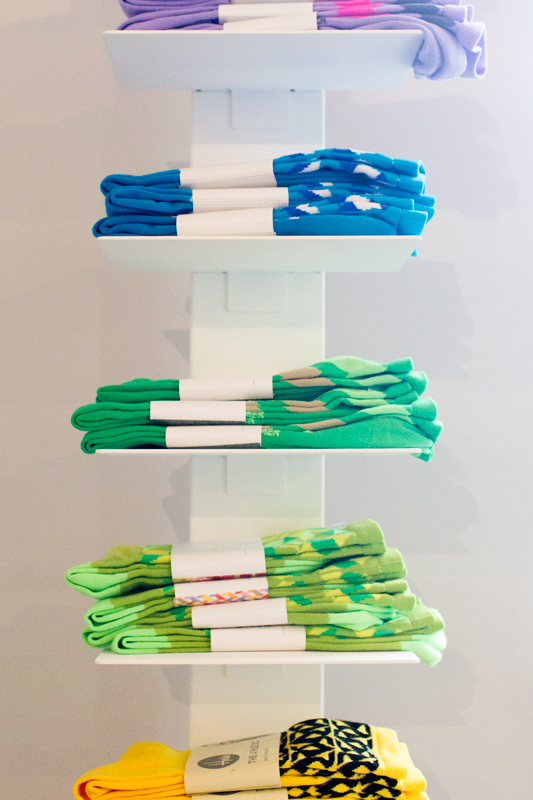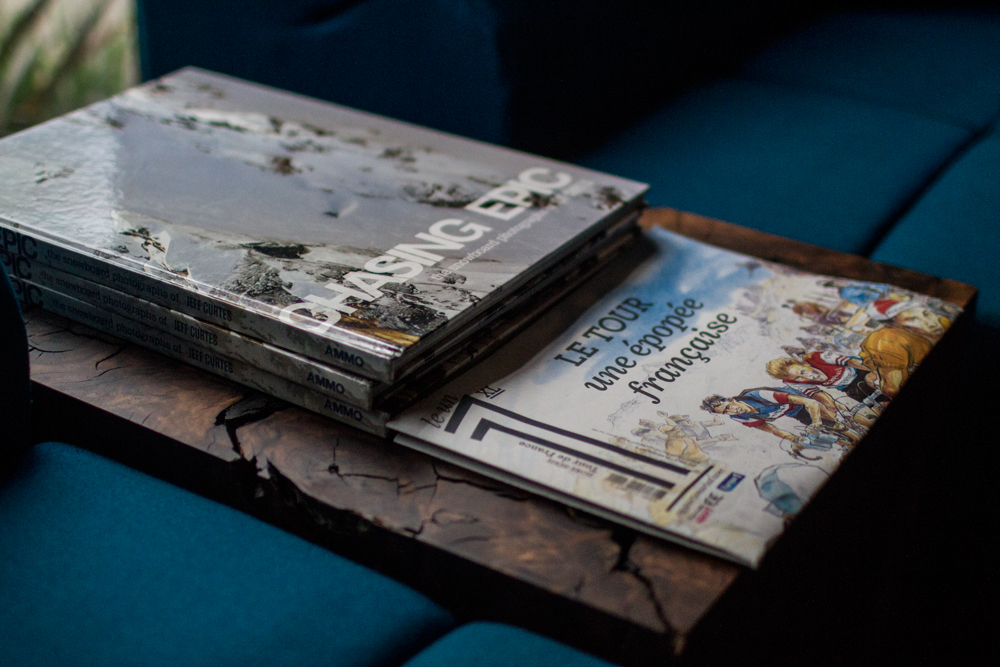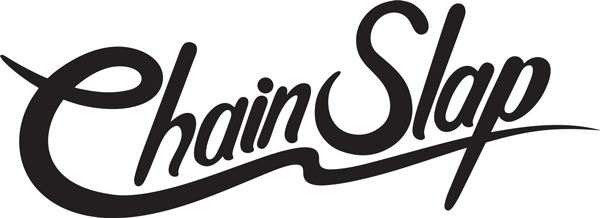“I don’t mind Kanye, he’s got some bangers.”
Jeremy paused…
“I didn’t say I minded him, you just said he’s a douche. That was the debate: do you still go on liking him? Obviously your answer is yes.”
I was in The Athletic Community, a minimalist but well-appointed shop in Portland that serves as the retail store for an expanding range of socks and athletic apparel. I was interviewing Jeremy Dunn. Together with his wife, Julie Krasniak, Jeremy had founded The Athletic and overseen its success from a tribute sock to a budding apparel range. In an adjoining section of the complex sat a gallery associated with the shop that had recently opened.
Jeremy passed as a convincing Portlander. He was clean cut, trendily dressed, and disdainful of umbrellas – favouring a collar turned up against the winter rain. As we chatted, he regarded me with a playfully scrutinising demeanour. If an interview ever really begins officially, it hadn’t at that point, yet we had already slid into a philosophical discussion: should we differentiate between artists as artists, and artists as people? I’m not sure I got Jeremy’s perspective on that question – I suspect because he was happy to let the question rebound to hear what I had to say.
Over the next hour, we discussed how a sock can build a trade, and how The Athletic, as a business and as a medium in itself, navigates the creative space and represents more than simply a place for cyclists to buy quirky socks.

How did you get into this?
How far back do you want me to go?
Were socks the genesis?
For this particular thing it was socks, and it was one particular sock. We made a sock that looked like the Portland airport carpet, and it went crazy. We made 72 pair of them and my wife Julie was like “I don’t know if I want you spending money on 72 pairs of socks, because if nobody buys them…”
I said “If nobody buys them, then we wear these socks for the rest of our lives.”
I think we sold like 200 or 250 of them in the first hour, and there was no real way to turn it off. So we kept doubling our order. And we kept doing that again. And doing that again. And then the airport called and they said “We want to buy the socks.”
It totally went crazy.
[Jeremy produces the sock]
And the people liked it just because it looked like the carpet?
Part of the reason why it took off was because they were about to tear out all of the carpet. And the carpet has this crazy following; people Instagram it and take pictures when they’re travelling. So I said on our product copy that we heard a rumour they were about to tear out all the carpet, so we wanted to pay tribute to that.
We got this huge influx of people who were saying “Can you substantiate this rumour?” and “You said they were going to tear it out, do you know for sure?” and all I could say was “I don’t know”.
I mean, somebody said it.
So then the airport called me and they said “Where did you hear that we were tearing out the carpet?” I said “I don’t remember.”
But, you know, they were.
Oh, they were going to tear it out?
Yeah, it became this huge thing. People were protesting.
Wow. Carpetgate.
Exactly. So it got really massive, we were in the New York Times. We were in travelling blogs. It was crazy.
Not only because of the sock gimmick, but also because of the scoop?
Right, the whole thing.
And this was when?
This was in… 2013.
And then there was this whole influx of people making products based on that. There was a t shirt; there were beer coasters; there were all kinds of knick knacks they were selling at the airport. So we can say that we kicked that off.
And what it did was led us to say “Well okay, let’s make another sock” and we made this crazy 3-pack of socks based on the tile wall at LAX. So then we had a little airport theme going. That one went crazy too. So then we just started making other crazy socks.
I think that first year we made something like 25 different styles, and we kind of realised it was a viable business. I was working at Rapha at the time, so I was doing that at night. Julie didn’t have a job so she was shipping everything out.
And so now with your retail store, you’ve sort of handpicked a few other different brands?
Yes, so we were really actually looking for a place to get 6000 socks out of our two bedroom apartment. Being in this building, I saw that another space had opened up. We were looking for somewhere just to run logistics and have a shipping department. But because it’s a Portland-centric thing, we got a pretty unusual number of requests from people to just pick them up. So we were having all these people stopping by our apartment to pick up socks.
Yeah, that’s kind of weird.
A little weird. So anyway we looked at this space, and there was a home furnishings store that was… awful. We said “Hmmm, that place is kind of crazy” but came in anyway and thought “Maybe we could do some retail at the same time?” That way people can kind of stop by.

And you’ve obviously got a sort of basketball thread running through here as well?
Yeah. When we first opened we didn’t have very many “other” brands. It was mainly just our socks, and it kind of blew my mind that people were coming this far for socks. But now it’s been kind of fun to have Kletterwerks, a backpack brand, and have a running cap brand, and then jackets – just to be able to pull in the stuff that we’re interested in.
And that was kind of the reasoning behind keeping the name so benign, instead of calling it “The Cyclist”. We do all these other things. We play basketball twice a week. We run on trails. It seemed like a better bet to be able to open it up to all kinds of different styles. That’s been pretty fun.
So how do you sit down and design a sock? Where do you begin? Obviously the airport one is kind of easy: it’s a tribute sock.
Yes, and it’s a pattern. We kind of set up a few general rules when we started, to maintain the space for design and pattern and not logos. That, I think, has been a good starting point for us.
But then we pull from everything. There are black and white basketball ones that our friend designed – he’s doing a crazy mural in Portland. We got that. We did some more airport ones, we’ve got a Boston and JFK themed one. We’ve got a Seattle themed one. Also, I went and did a run in Japan. So I teamed up with a designer there. He designed a collection that feels very Japanese.
I would say it comes from everywhere. We just did a pair of socks for our friends who are racing the Cape Epic, and my wife Julie had raced in Africa before, so she had all these photos that she had taken there. She found this photo of this plant that she was really into, so she came up with this pattern and placed that over the top.
We just dip into the well wherever. I recently did a sock for Levis commuter and I was just looking at Japanese textile books and found something that I was really into and went with it.
The collaborations would be exciting, right? Because you get somebody else’s perspective on it?
Yeah, totally. The tough thing is that we’ve got five collaborations happening at the moment, and nothing that’s just ours.
Do you think that, from a design perspective, this has been a bit of a phenomenon post-2010: people redesigning bike kit to, you know, get rid of this billboard bullshit and do patterns and designs? And do you think that you were doing this at the right time?
Yeah, I would say for sure. I worked at Rapha from 2007 until two years ago. I would say, at least for me, they were one of the first to go subtle. But then when they go crazy it works somehow.

Do you find that challenging? Working out what’s going to be innovative, and what’s perhaps going too far? Have you had many dud designs?
Honestly, we really haven’t. There have been a few colourways that haven’t necessarily worked as well as others. We do these collections where we do one pattern over four different variations and some colours will work over others.
But what’s crazy to me is that we had this orange and purple sock that I hated, and Julie was like “We’re doing this sock.”
I said “Okay, whatever, I’m not going to fight with you over it.”
And it didn’t do very well initially, and we were almost done with all those socks, but then we kept getting these requests for it. People were like “Where’s that sock, I’ve been looking for it – I’ve seen it on Instagram!” People were seeking it out.
[Laughing] Sock stalkers?
Yeah. And she’s done really well, Julie, she does a really good job of coming up with crazy patterns and colour combinations.
Do you just sort of follow your gut on when to refresh something or do something new? You don’t have, say, set redesign intervals or seasonal releases?
No, we kind of made a decision early on to stay away from solid seasonal releases. What we did instead was at least something new each month, which can be super frustrating but also keeps the conversation going throughout the year, instead of having it come in and drop, and then having all this excitement around it, and then two months down the road it’s the same stuff.
It’s almost like clockwork, once a month we’ve got something new. In fact, for two years now I’ve been working on this package to do a “sockscription” where you can just sign up for the whole year and get something each month show up in the mail.
That’s a cool idea. It’s not rolling yet?
No, it’s not rolling yet. But we’ll see.
And the gallery – you just felt like, what, you didn’t have enough going on already?
[Laughs] Well, it kind of came down to us being in this amazing building. And we noticed that people would be drawn in here to shop and then continue down the hall. But there’s nothing down there. There’s a bunch of architects and they keep their shades drawn.
We got that other space because we didn’t want another architect. Initially, we were hoping to have a little holiday market set up with more other brands, hyper-focussed on outdoors. And that idea kind of floundered a little bit, so we said “It’s a super cool space, let’s make it into a gallery.”
So are you hoping that the gallery will be a sort of germ that develops into this area and draws more work in?
Totally. Twofold. You’ve got that, but also we have a big publications section in our shop because I used to have my own magazine. So then we’re using that other space to start producing some publications again. We made a book from this show and we’ll be making a book for each show, which will be kind of a catalogue of the show but also a little bit more back story.
Then the hope is, say you do 10 shows throughout the year, you’ve got all these books. In between, you can fill in with other stories that you’re trying to tell.
So you personally, this all seems like a creative drive that is finding quite a few different expressions, do you feel like you just have to be doing stuff like this?
Me, personally? Totally. I think once I first made my magazine [Embrocation Cycling Journal], I knew it was what I needed to do. I needed to keep making and telling stories. That’s where I feel the best.
That’s what I did for Rapha: managed all the content that North America was producing, social media or photoshoots or the Rapha Continental, that kind of stuff. This is just an extension of that, arguably maybe the fullest or realest extension of that.
What about the name? How’d you come up with the name?
The Athletic Community? I race with this guy, Pete Rubi, and he’s one of my dearest friends, he’s an artist and a creative and crazy person. And I think one season, we did like 28 cyclocross races over the course of a season, all on the East Coast, travelling up and down.
We were amateur bike racers, for sure, but we had fun with it. And we would get very competitive with other teams and be like “Ahh, fuck those guys” or whatever. Pete’s response was always:
“Oh, guys, we’re all part of the athletic community.”
When I moved away from the East Coast, and people would start to naysay, and especially when I was working at Rapha and people would say “Ohhh, it’s too fucking expensive” or “You guys are posers” or whatever, we’d say “Hey, we’re all part of the athletic community here, guys.”
So that’s where the name came from.
Sort of half inside joke?
Yeah, which is the best way to go.
Portland is such an exciting city to be doing what you’re doing, it seems like a hub of progressive ideas around the sport and culture.
Sure, and it’s super supportive. It amazes me how people come in and say “This is great, I’ve never seen it before, I’m gonna come back.” And they do. There’s a lot of sport happening in this city too. It amazes me that I can put together two nights a week of basketball, and 20 different people show up each time. You can go trail run and see all kinds of people up there on that amazing network of trails. The cycling community is super vibrant. The jiu jitsu community is awesome and totally crazy.

Have you had anything particularly exciting recently?
Fabian Cancellara had a new bike coming out before Paris-Roubaix and we made socks for Trek to release in all of their markets.
We actually do quite a bit of side promo work for companies, that stuff is super cool. It’s always great when brands come to you and say “Do whatever you do” and you say “What do you think about this?” and all you get back is “Great, go for it.” That’s amazing, and fun work.
The only tough thing is that it takes away from the other stuff you need to do. And in terms of myself personally, I need to play basketball or run or ride bikes or I’ll go crazy.
I know what you mean, if I haven’t run or something for a few days I start going crazy. But you don’t realise, you don’t feel it coming on, and then all of a sudden you’re arguing about muesli or something and you’re like “Oh, I’m sorry.”
For sure. I ran track and field in college and right after that I lived with this lady and just stopped. I was totally burnt out on it. She eventually said “You need to get back into moving around, because you’re an asshole”. I was like “Oh, okay, you’re right.”
You’ve got some exciting stuff coming in the future. Do you have bigger ambitions too?
Yeah, I would like to do more sportswear in general. We have sweatpants and a shirt that we designed from the ground up – we have a pattern and some materials and stuff. We’re just trying to find someone to make that at the moment.
I’d like to get into making our own products. I would say probably the biggest trick for us is going to be to not spread ourselves too thin, and I know there’s humour in saying that since we’re saying “Oh, let’s open up galleries, and make some sweatpants”. But to be able to focus is valuable.
And to make sure what you are doing is quality?
That we’re doing it well, sure.
The interview petered out naturally, and the impression I was left with was that Jeremy is thorough, professional and fundamentally creative. The Athletic was much more than a trendy storefront that vended wacky socks; it was an original space, wired into the art, culture and soul of Portland.
Although the progressiveness of Portland and its reputation for industry-leading products no doubt helped The Athletic along, it was clear that its true success owed much to Jeremy’s uncompromising vision. It was almost beyond question that he should be spending his days finding creative expression through his work. That translated into the quality of The Athletic’s products and feel.
It was deeply refreshing to discuss products and concepts with a person whose passion permeated them, as opposed to a marketing manager who was propped up to deliver a rehearsed spiel. After all, anyone can print goofy shit on a pair of socks and call it fun. Evidently, something more is required to be truly interesting.
Check out the latest news and designs at www.theathleticcommunity.com



Leave a Reply